Ijraset Journal For Research in Applied Science and Engineering Technology
- Home / Ijraset
- On This Page
- Abstract
- Introduction
- Conclusion
- References
- Copyright
A Review on Cloud Computing Technology, Cloud Deployment and Service Delivery Models
Authors: Divya T. Gandecha, Vaishnavi J. Mahale, Yogesh G. Rahangdale, Pallavi S. Ayalapurkar, Sonal V. Sawarkar
DOI Link: https://doi.org/10.22214/ijraset.2022.40022
Certificate: View Certificate
Abstract
With the advent of Cloud Computing technology, organizations are rapidly shifting their IT systems from traditional client/server to cloud computing model where everything is offered as a service whether it’s a software, hardware or storage capacity. Cloud computing uses the concept of pay as per use basis where users do not need to pay for infrastructure, installation and its maintenance. Anyone can access the desired service from the cloud anytime, anywhere in the world on demand basis. The utilization of this innovative technology makes collaboration easier among companies or organizations and has the potential to create financial and operational benefits. This study helps organizations and individuals understand how cloud computing can provide them with reliable, personalized and cost-efficient services in a wide variety of applications.
Introduction
I. INTRODUCTION
Information technology facilitates collaboration among distant workers easier than ever because of the growing competitive atmosphere of the business world. Organizations can keep track of the external operating environment by creating linkages between suppliers, distributors and customers through a company’s centralized location using web-based software [3]. Cloud computing is a model that can be quickly provisioned and released with minimal management effort or service provider interaction for enabling convenient and on-demand network access to a shared pool of configurable computing resources. With the exploit of this technology, users can access heavy applications via lightweight portable devices such as mobile phones, PCs and PDAs [1].
It is very important for businesses or organizations to know their requirements before opting for various cloud deployment models available. Cloud can be deployed in several different ways based upon applications, attributes, business requirements of an organization. There are primarily four cloud deployment models: public, private, hybrid and community models. These four cloud deployment models are discussed below in this paper, along with scenarios in which a business could opt for each. Each company chooses a deployment model for a cloud computing solution based on their required business, operational, and technical requirements [6]. We will also discuss various service models of cloud computing. In general cloud providers offer three types of services i.e. Software as a Service (SaaS), Platform as a Service (PaaS) and Infrastructure as a Service (IaaS) [1]. All these services are discussed in detail in the paper. The structure of the paper is organized as follows: Section II gives an overview of cloud computing technology, Section III explains types of cloud deployment models, Section IV shows the table of comparison of these deployment models, Section V explains various service models of cloud computing, Section VI and VII describes the characteristics and applications of cloud computing respectively and lastly, Section VIII concludes the paper.
II. CLOUD COMPUTING
Cloud computing, in its many forms, has become an essential part of IT. The term ‘cloud’ has been used to refer to platforms for distributed computing- a cluster of servers, network, software, interface, etc. which are required for the user to carry out a particular task. ‘Computing’ refers to the delivery of this cluster as a service to the user where the user can use it as and when required. The user is relieved from owning a huge computing infrastructure and requiring upfront investment in it. Rather, it allows the user to use a similar infrastructure owned by another party at his/her own responsibility and pay only for the time it is being used. This pay-per-use model enables convenient and on-demand network access to a shared pool of configurable computing resources such as servers, storage, applications, and services [3].
Cloud computing is one of the most promising and anticipated technologies in recent years. The technology is not a new concept for most of the sectors and with proper planning could increase operational efficiency. For some users, the driving directive to “go all-in on the cloud” is a sure way to cut hardware costs. For others, the cloud will streamline operational efficiency and speed up development. Various deployment models of cloud computing makes the acquisition attractive for any type of sector, depending on the need or usage[3].
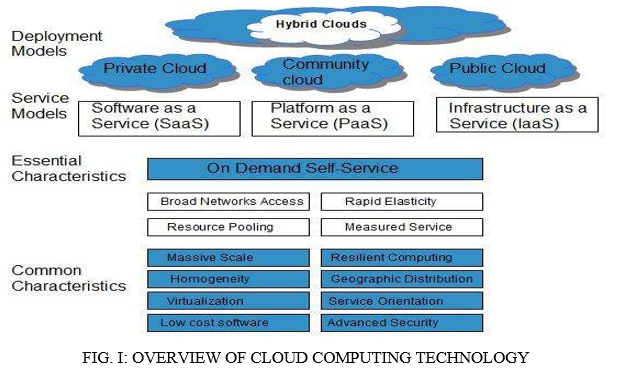
III. DEPLOYMENT MODELS OF CLOUD COMPUTING
Choosing the suitable type of cloud computing to be implemented by an institution is the first important step to take as it promises a successful cloud computing implementation by that institution as different types of cloud computing require diverse skills and resources [5]. Cloud can be deployed in several different ways based upon applications, attributes, and business requirements of an organization. There are primarily four cloud deployment models: public, private, hybrid and community models. Each company chooses a deployment model for a cloud computing solution based on their specific business, operational, and technical requirements. These four cloud deployment models are discussed below [6]:
A. Public Cloud
This cloud infrastructure such as storage, applications and other services is made available to everyone and users only pay for the time duration they use the service i.e. pay-per-use. However public clouds are less secure because all the applications and data are available to all users. Example: Google App Engine, IBM smart cloud [2].
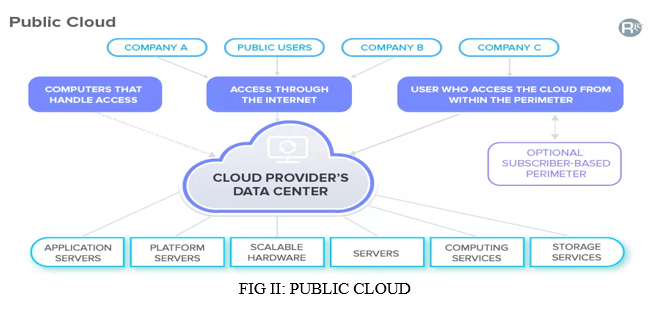
Benefits of Public cloud
- Availability and Reliability
- Pay as per use
- Freedom of Self-Service
B. Private Cloud
This cloud infrastructure is implemented in a single organization and available to limited users which are part of that specific organization. Its resources and applications are controlled by the organization itself. So, it improved the security of the private cloud. Example: Amazon PVC, Ubuntu Enterprise Cloud [2].
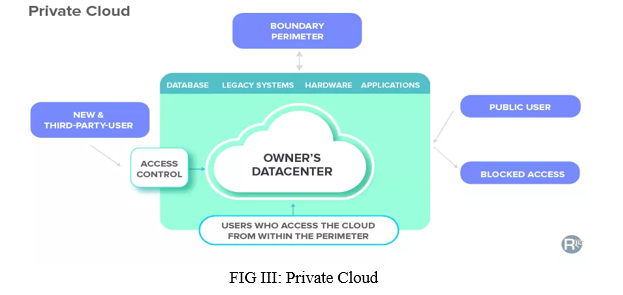
Benefits of Private Cloud
- High Level Security
- Utilization of existing resources
- Full control to customize
C. Hybrid Cloud
This deployment model is the composition of more than one cloud in which critical data is hosted on the private cloud and less secure data on the public cloud. The merging of these two cloud models uses a concept called Cloud Bursting. The idea of hybrid clouds that extend the use of infrastructure by hiring additional capabilities from public clouds is also known as Cloud Bursting. Example: EMC Hybrid Cloud, HP Hybrid Cloud [2].

Benefits of Hybrid cloud
- Cost reduction
- High availability
- More secure
D. Community Cloud
Community cloud involves the distribution of computing infrastructure in between organizations of the same community. The infrastructure and computational resources of a cloud are unique to two or more organizations that have common privacy, security, and regulatory considerations. This may help in reducing the capital costs for its setup as the costs are distributed among the organizations. Example: Google's "Gov Cloud" [2].
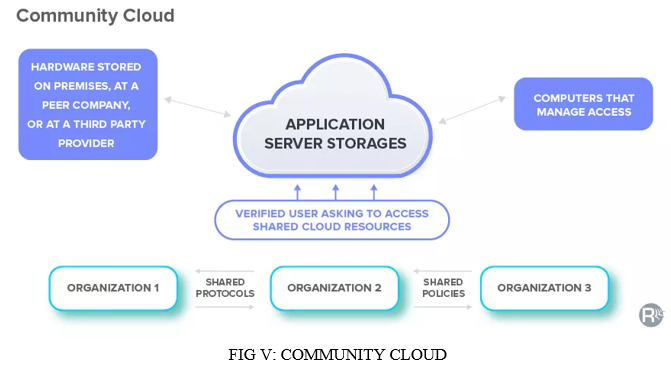
Benefits of Community cloud
- Lower cost than private cloud
- Limited users
- High security
IV. COMPARISON OF CLOUD DEPLOYMENT MODELS
Table I
Comparison Among four Types of Deployment Models
|
Parameters |
Public |
Private |
Hybrid |
Community |
|
Ownership |
Owned by customers |
Owned by single organization |
Partially owned by Service Provider and partially by consumer |
Owned by two or more organizations which has common goal |
|
Ease of Setup |
Very easy to set up, the provider does most of the work |
Very hard to set up as your team creates the system |
Very hard to set up due to interconnected systems |
Easy to set up because of community practices |
|
Ease of use |
Very easy to use |
Complex and requires an in-house team |
Difficult to use if the system was not set up properly |
Relatively easy to use as members help solve problems and establish protocols |
|
Performance |
Low to medium |
Excellent |
Good |
Very Good
|
|
Setup cost of building data center |
Low initial cost |
High |
Medium |
Varies from number of organizations |
|
Setup flexibility |
Little to no flexibility, service providers usually offer only predefined setups |
Very flexible |
Very flexible |
Little flexibility, setups are usually predefined to an extent |
|
Demand for in-house hardware |
No |
In-house hardware is not a must but is preferable |
In-house hardware is not a must but is preferable |
No |
|
Used by |
Anyone can access |
Limited people can access |
Medium accessibility |
Depend upon number of cooperatives |
|
Security and Privacy |
Less |
Highest |
Medium |
High |
|
User’s control |
Limited control |
Full control |
Full control over private part and limited at public part |
High control but limited by community policies |
|
Maintenance cost |
Lowest |
Highest |
Moderate |
High |
|
Space required |
Very low |
Very large |
Medium |
Depends on number of cooperatives |
|
Workload |
Normal workload with short-spikes in demand |
Not suitable for handling large workload |
Highly dynamic or changeable |
Suitable for handling large workload |
|
Size of Data Centers |
Large |
Small |
Very large |
Medium |
|
Virtualization |
Resource utilization is optimized via server virtualization |
Resource utilization efficiency gains through server virtualization |
Resource utilization is optimized via server virtualization |
Resource utilization efficiency gains via server virtualization |
|
Reliability |
Medium |
Highest |
Medium |
High |
|
Infrastructure Require |
Off-Premise only |
OnPremises or at a third-party |
Can be On or Off-Premise |
Can be On or Off- Premise |
|
Integration |
Very Difficult |
Very Easy |
Difficult |
Easy |
|
Cloud Bursting |
Not supported |
Not supported |
Supported |
Not supported |
|
Example |
Google App Engine, IBM Smart Cloud, Amazon EC2 |
Amazon PVC, Ubuntu Enterprise Cloud, Microsoft Azure |
EMC Hybrid Cloud, HP Hybrid Cloud, Rackspace Hybrid cloud |
Microsoft government community cloud |
V. SERVICE MODELS OF CLOUD COMPUTING
Cloud computing delivered IT resources and capabilities as a Service. National Institute of Standard Technology (NIST) recognized “three service models” which provide services for cloud computing [2]. The cloud service delivery models are described as follows:
A. Software as a Service (SaaS)
SaaS is a fully developed software solution ready to buy and use over the Internet by subscription. The SaaS provider manages the infrastructure, operating systems, middleware, and data necessary to deliver the program, ensuring that the software is available when and where customers need it. Many SaaS applications run directly through web browsers, eliminating the need for downloads or installations. SaaS applications allow businesses to get up and running quickly and scale operations quickly. You do not need to purchase or implement the hardware and software used to deliver your business services [4]. This platform provides users with a data storage interface and charges them on the basis of amount of storage used. The interface can be used by any of the other three service model architecture types or accessed directly by users[3].
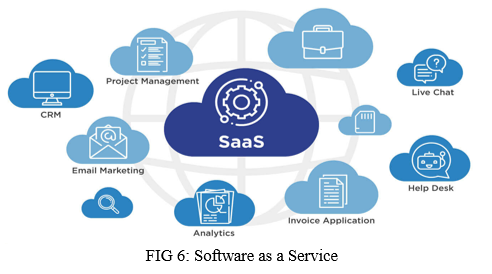
Advantages: [2]
- SaaS provides lots of application to accesses.
- Eliminates the need to install an application
- Support many concurrent users at once.
Examples of SaaS: Microsoft Office 365, Salesforce, Cisco WebEx, Google Apps [4].
B. PaaS (Platform as a Service)
It uses the same basic infrastructure as IaaS, but also includes the operating systems, middleware, development tools, and database management systems necessary to create software applications. PaaS is extremely useful for any company that develops web-based software and applications. Many of the tools required to develop for multiple platforms (computers, mobile devices, browsers, etc.) can be quite expensive. Customers can access the development tools using PaaS cloud service.[4] Platform as a Service is a model which offers deployment of applications by reducing the cost of buying and maintaining hardware and software[2].
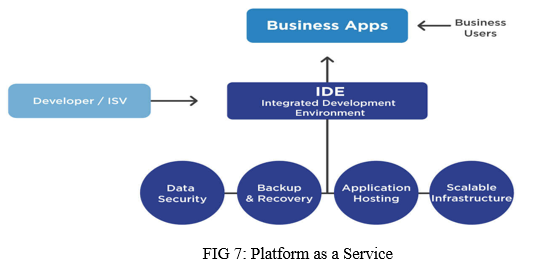
Advantages: [2]
- Pay for use of the infrastructure.
- Multitenancy architecture.
- Provide reliability and security.
Examples of PaaS: AWS Elastic Beanstalk, Apache Stratos, Google App Engine, Microsoft Azure [4].
C. IaaS (Infrastructure as service)
IaaS is the most comprehensive and flexible type of cloud service. Essentially, it provides a fully virtualized computing infrastructure that is provisioned and managed over the Internet. An IaaS provider manages the physical edge of the infrastructure (servers, data storage space, etc.) in a data center, but allows customers to fully customize those virtualized resources to meet their specific needs.[4] This platform provides general purpose support services including infrastructure services such as database, storage capacity, networking, and other computing resources. The user has control over operating systems and deployed applications.[2]
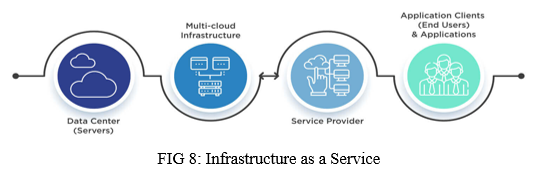
Advantages: [2]
- Provides resources as a service.
- Pay IaaS services on a usage basis.
- Dynamic scaling is allowed
Examples of IaaS: Microsoft Azure, Amazon Web Services (AWS), Cisco Metacloud, Google Compute Engine (GCE) [4].
VI. CHARACTERISTICS OF CLOUD COMPUTING
Cloud computing systems satisfy many interesting characteristics that make them promising for future IT applications and services and we describe them below: [7]
- On-demand self-Service: Cloud services such as CUP time, Storage, network access, server time, web applications etc can be allocated automatically as required by the consumers without any human interaction.
- Cost Effectiveness: Services provided by the cloud service providers are very cost effective if not free. The billing model is pay as per usage; there is no need to purchase the infrastructure and therefore lowers maintenance cost.
- Broad Network Access (mobility): Consumers can access cloud resources over the Internet all the time and from anywhere (i.e., ubiquitous) through different types of devices (e.g., mobile phones, laptops, and PDAs).
- Resource Pooling: Physical and virtual computing resources are pooled into the cloud. These resources are not dependent on location in the sense that the customer has no control nor has knowledge over their location.
- Rapid Elasticity: Computing resources can be rapidly and elastically provisioned and released based on the demand of the consumer. Consumers view these resources as if they are infinite and can be purchased in any amount at any time.
- Measured Services: Cloud resources and services are monitored, controlled and optimized by the CSPs through a pay-per-use business model. Consumers utilize these services in a way similar to utilizing electricity, water and gas.
- Multitenancy: A cloud provides services to many users at the same time. Those users share cloud resources at the network level, host level and application level, however, each user is isolated within his customized virtual application instance.
- Scalability: The infrastructure of cloud computing is very scalable. Cloud providers can add new nodes and servers to cloud with minor modifications to cloud infrastructure and software.
- Reliability: It is achieved in cloud computing by using multiple redundant sites. High reliability makes the cloud a perfect solution for disaster recovery and business critical tasks.
- Economies of Scale: In order to take advantage of economies of scale, clouds are implemented to be as large as possible. Other considerations are also taken to reduce cost such as locating the cloud close to cheap power stations and in low cost real estate.
- Customization: A cloud is a reconfigurable environment that can be customized and adjusted in terms of infrastructure and applications based on user demand.
- Efficient Resource Utilization: Delivering resources only for as long as they are needed allows for efficient utilization of these resources.
- Virtualization: Cloud computing makes the user get service anywhere, through any type of terminal. The resources it needs come from the cloud instead of visible entities. You can complete anything you want through net service using a laptop or a mobile phone. Users can attain or share it safely through an easy way, anytime, anywhere. Users can complete a task that can’t be completed in a single computer.
VII. APPLICATIONS OF CLOUD COMPUTING
Cloud computing is one of the most dominant fields for online resources because cloud makes sharing and handling resources very simple. Due to these attractive properties of the cloud, following are the fields where cloud as an active component: [2]
- Cloud Computing in Medical Fields: Cloud computing plays a vital role in the medical field as it provides various infrastructure at a very low cost to give more accurate results. Cloud computing helps in sharing medical information among the various medical professionals who can contact any individual patient directly anytime and anywhere.
- Cloud Computing in Education: Cloud computing offers hardware and software infrastructure to an educational environment so that academic institutions remain focused on research and learning instead of buying and maintaining complex IT infrastructures. It allows retrieving information and using resources which are useful for educational purposes. E-Learning provides online tests, online courses etc.
- Online Entertainment/Social Area: People also use the cloud for entertainment purposes such as online gaming, online media stores etc. Online Entertainment can be reached to users by any device such as smartphones, tablets etc. It helps in staying connected with various people around the world. For example, Facebook, Google etc.
- E-Governance: E-governance is the electronic way to share information between government and citizens and among government organizations. E-governance requires resources such as software, hardware, security to work properly and these requirements are fulfilled by cloud computing as it provides these resources as a service.
- Cloud Computing in Agriculture Field: Agricultural Field is catching height using Cloud Computing technology. It stores all the relevant information at one place so that users like farmers, consultants etc. can access it easily using any device. This information includes various soil related databases, weather related information, different crops data etc.
Conclusion
In this paper, we presented a broad study on cloud computing, their deployment models, service models, characteristics and applications. The paper also discusses the comparison of all cloud computing deployment models in table form. Different cloud models can be selected varying upon the specific desires of the organization. Cloud computing emerges as a rapidly evolving technology. More and more companies are willing to take on cloud computing in order to improve collaboration. While the list of the uses of cloud computing is not exhaustive, it certainly gives incentives to use the cloud when compared to more traditional alternatives to increase IT infrastructure flexibility. The world is rapidly migrating towards the cloud due to its cheap cost and efficient utilization of resources. This study concluded that cloud computing will affect many people in the organization and has a significant impact on IT investment and costs.
References
[1] Mervat Adib Bamiah, Sarfraz Nawaz Brohi - “Exploring the cloud deployment and service delivery models”, International Journal of Research and Reviews in Information Sciences (IJRRIS), Volume 1, No. 3, September 2011. [2] Mohammad Haris, Rafiqul Zaman Khan - “A systematic review on Cloud Computing”, International Journal of Computer Sciences and Engineering (IJCSE), Volume 6, Issue-11, November 2018. [3] Mohsen Attaran - “Cloud Computing Technology: Leveraging the Power of the of the Internet to Improve Business Performance”, Journal of International Technology and Information Management (JITIM), Volume 26, Issue-1, 2017. [4] Prof. Hiral B. Patel, Prof. Nirali Kansara - “Cloud Computing deployment models: A comparative study”, International Journal of Innovative Research in Computer Science & Technology (IJIRCST), Volume 9, Issue-2, March 2021. [5] Tinankoria Diaby, Babak Bashari Rad - “Cloud Computing: A review of the Concepts and Deployment Models”, International Journal of Information Technology and Computer Science (IJITCS), June 2017. [6] Dr. Rahul Malhotra, Prince Jain - “How to Choose an Economic Cloud Deployment Model”, International Journal of Computer Trends and Technology (IJCTT), Volume 4, Issue 8, August 2013. [7] Aaqib Rashid, Amit Chaturvedi - “Cloud computing characteristics and services : A brief review”, International Journal of Computer Sciences and Engineering (IJCSE), Volume 7, Issue 2, Feb 2019.
Copyright
Copyright © 2022 Divya T. Gandecha, Vaishnavi J. Mahale, Yogesh G. Rahangdale, Pallavi S. Ayalapurkar, Sonal V. Sawarkar. This is an open access article distributed under the Creative Commons Attribution License, which permits unrestricted use, distribution, and reproduction in any medium, provided the original work is properly cited.

Download Paper
Paper Id : IJRASET40022
Publish Date : 2022-01-20
ISSN : 2321-9653
Publisher Name : IJRASET
DOI Link : Click Here
 Submit Paper Online
Submit Paper Online

